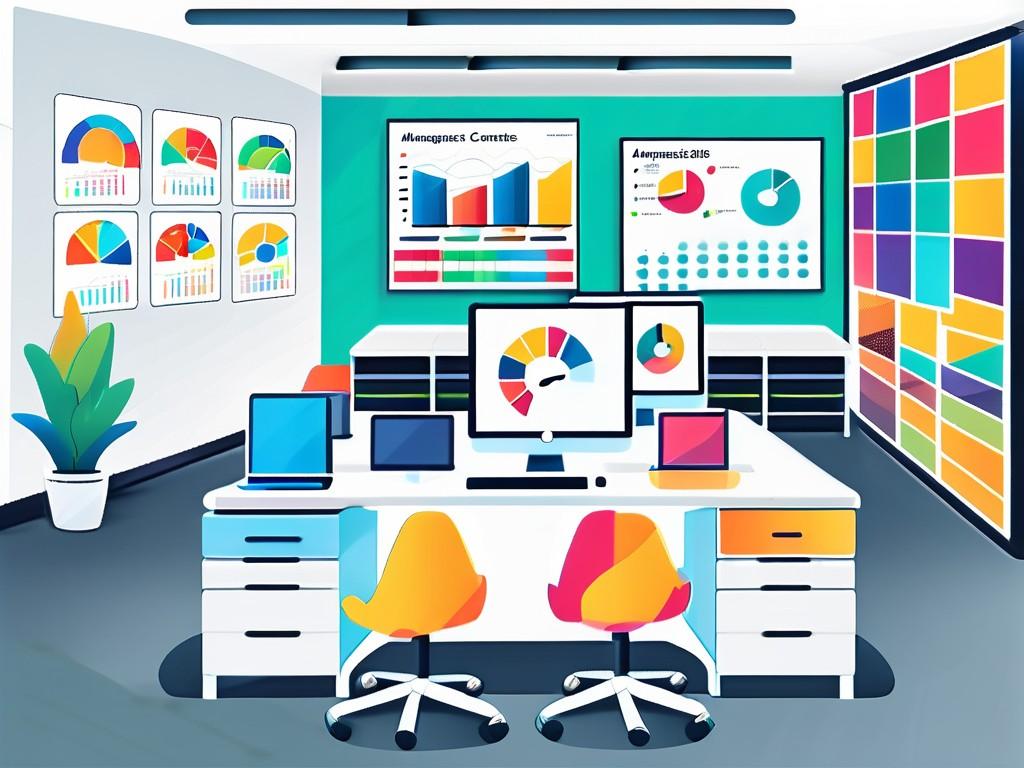In the ever-evolving landscape of childcare management, administrative tasks are becoming increasingly complex. To navigate these complexities, childcare centers are turning to advanced administrative tools. This article explores the importance of these tools, their various types, and how to implement them effectively.
Understanding the Importance of Advanced Administrative Tools
Childcare centers deal with a multitude of operational tasks, ranging from attendance tracking to communication with parents. The necessity for efficiency in these processes cannot be overstated. Advanced administrative tools help streamline operations, freeing up time for educators to focus on what truly matters – the children.

Moreover, these tools can enhance organizational culture. By using them, staff feel supported in their roles, which can lead to increased job satisfaction and reduced turnover. A well-structured administrative process also reflects positively on the center, reassuring parents that their children are in capable hands. This sense of professionalism not only attracts high-quality staff but also builds trust with families, who are often looking for environments that prioritize both education and emotional well-being.
The Role of Administrative Tools in Childcare Centers
Administrative tools serve as the backbone of daily operations in childcare centers. They assist in the coordination of staff schedules, manage enrollment processes, and facilitate effective communication between educators and parents. By automating routine tasks, these tools alleviate the administrative burden, allowing childcare providers to concentrate on delivering quality care.
Furthermore, they provide essential analytics and reporting features, enabling centers to make informed decisions. This data-driven approach empowers management to identify areas needing improvement, resulting in more strategic planning and resource allocation. For instance, tracking attendance patterns can highlight peak times for enrollment, while monitoring staff performance can help in tailoring professional development opportunities that align with the center’s goals.
Schedule a free 30-minutes session with us!
Benefits of Implementing Advanced Tools
The benefits of incorporating advanced administrative tools in childcare centers are numerous. Firstly, they enhance operational efficiency. Automated systems significantly reduce time spent on manual tasks, allowing staff to invest more time in childcare and development activities.
Secondly, these tools foster better communication. Real-time updates about children’s progress, health, and activities can be shared with parents seamlessly, strengthening the relationship between home and the center. Ultimately, improved communication leads to heightened engagement from families, which is crucial for a child’s development. Additionally, features such as parent portals can provide a platform for parents to access resources, schedule meetings, and even participate in community events, further bridging the gap between home and school.
Lastly, data security and compliance become more manageable. With advanced tools in place, sensitive information is protected through encryption and secure access protocols, ensuring that childcare centers adhere to regulations while safeguarding personal data. This not only protects children and families but also builds a reputation for the center as a trustworthy institution. As regulations continue to evolve, having robust administrative tools can help centers stay ahead of compliance requirements, allowing them to focus on what they do best – nurturing and educating young minds.
Exploring Different Types of Advanced Administrative Tools
As the demand for efficiency in childcare centers grows, a variety of advanced administrative tools have emerged to meet these needs. Each tool serves a unique purpose but collectively contributes to improving overall operational performance.
Digital Attendance Systems
Digital attendance systems are transforming how childcare centers track the presence of children. Traditional paper methods can be cumbersome, prone to errors and time-consuming. Advanced digital systems allow for real-time attendance tracking through biometric identification or mobile check-ins.
This not only streamlines the process but also provides parents with peace of mind, knowing they can monitor their child’s attendance from a distance. The data gathered can also help in understanding trends and patterns, which can be crucial for staffing and resource management. Moreover, these systems often integrate with emergency protocols, ensuring that attendance records are readily available in case of an urgent situation, thus enhancing the safety and security of the children.
Communication Platforms
Effective communication is vital in childcare settings. Advanced communication platforms facilitate seamless interaction between educators and parents. These platforms can include messaging systems, parent portals, and social media integration, ensuring that important updates or events are communicated efficiently.
Additionally, these tools allow for the sharing of multimedia content, such as photos and daily reports, providing parents with a window into their child’s everyday activities. Such engagement can drastically improve parent satisfaction and trust in the center’s capabilities. Furthermore, many of these platforms offer multilingual support, catering to diverse families and ensuring that language barriers do not hinder communication, thus fostering a more inclusive environment.
Scheduling and Planning Software
Scheduling and planning software is essential for managing staff schedules, classroom assignments, and resource allocation. With a user-friendly interface, these tools simplify the planning process, making it easy to adjust for unexpected absences or changes in enrollment.
Furthermore, advanced scheduling software can help in identifying patterns in center usage, allowing management to forecast needs and optimize staff deployment. This proactive approach ensures that every child receives the attention they deserve while maintaining a balanced workload for staff. Additionally, some software solutions come equipped with analytics features that provide insights into staff performance and classroom dynamics, enabling administrators to make informed decisions about training and development opportunities that can enhance the overall quality of care provided in the center.
Steps to Implement Advanced Administrative Tools
The successful implementation of advanced administrative tools requires careful planning and execution. By following a structured approach, childcare centers can maximize the benefits of these tools and ensure a smooth transition.

Assessing Your Current System
The first step in implementing new administrative tools is to assess the current systems in place. Identify pain points such as time-consuming tasks, ineffective communication channels, or inadequate data management practices. This analysis will provide insight into the specific needs of your center and help tailor the new tools to address them effectively. Additionally, consider gathering input from various stakeholders, including teachers, administrative staff, and even parents. Their perspectives can reveal hidden challenges and opportunities that may not be immediately apparent, ensuring a more comprehensive understanding of the current landscape.
Schedule a free 30-minutes session with us!
Choosing the Right Tools for Your Center
Once you have a clear understanding of your needs, the next step is selecting the appropriate tools. Research various options and consider factors like user-friendliness, scalability, and integration capabilities with existing systems. Consulting with staff and gathering feedback can also inform your decision-making process, ensuring that the tools chosen will be embraced by the team. It may also be beneficial to explore case studies or testimonials from other childcare centers that have successfully implemented similar tools. This can provide valuable insights into potential pitfalls and best practices, helping you make a more informed choice.
Training Staff on New Tools
Implementing advanced tools is futile without proper staff training. Organize comprehensive training sessions that cater to different learning styles and schedules. Providing hands-on experience will not only boost confidence among staff but also facilitate smoother integration into day-to-day operations. Consider implementing a phased training approach, where staff can gradually learn the functionalities of the tools over time rather than all at once. This method can reduce overwhelm and allow for more focused learning on specific features as they become relevant to daily tasks.
Continuous support should also be available as staff familiarize themselves with the new tools. This can include quick reference guides, FAQs, and access to dedicated support teams, ensuring that all team members feel competent using the new systems. Additionally, fostering a culture of open communication where staff can share their experiences and challenges with the new tools can create a supportive environment. Regular check-ins and feedback sessions can help identify ongoing issues and provide opportunities for further training or adjustments to the tools, ensuring that the implementation remains effective and responsive to the needs of the center.
Measuring the Impact of Advanced Administrative Tools
Implementation is just the beginning; measuring the impact of advanced administrative tools is crucial for verifying their efficacy. Regular assessments can highlight areas of success and those needing modifications.

Efficiency in Daily Operations
One of the first measures of impact is assessing efficiency in daily operations. Evaluate time saved in administrative tasks, changes in staff workload, and overall productivity levels since tool implementation. Observing these metrics will illustrate the tools’ effectiveness in streamlining processes. For instance, if a scheduling tool reduces the time spent on managing staff shifts and parent meetings, this can free up valuable hours that educators can redirect towards direct interactions with children, thereby enhancing the quality of care and education provided.
Improved Communication and Engagement
Monitor communication patterns between parents and educators to gauge improvements in engagement. Collect feedback from parents through surveys or informal conversations to understand their perspectives on accessibility and responsiveness. Enhanced communication can significantly elevate the experience for both parties. Additionally, tracking the frequency and nature of communications can reveal trends, such as increased participation in school events or a rise in parent inquiries about their child’s progress, indicating a deeper investment in their education.
Enhanced Data Security and Compliance
Assessing data security measures post-implementation is vital in ensuring that sensitive information remains protected. Regular audits and compliance checks should be conducted to validate that advanced tools meet regulatory requirements, thus fostering trust among parents regarding data handling practices. Furthermore, training staff on best practices for data security can bolster these efforts, ensuring that everyone understands their role in safeguarding information and can respond effectively to potential breaches.
In addition to these measures, it is essential to consider the long-term implications of advanced administrative tools on the overall culture within the childcare center. As staff become more comfortable with technology, they may find innovative ways to integrate these tools into their daily routines, leading to a more collaborative and proactive environment. This cultural shift can foster a sense of ownership among staff, encouraging them to contribute ideas for further improvements and adaptations that align with the center’s evolving needs.
